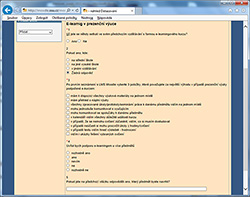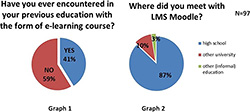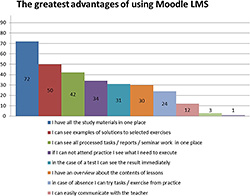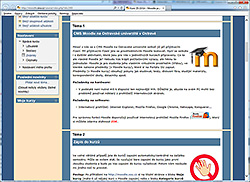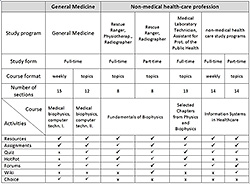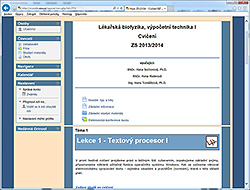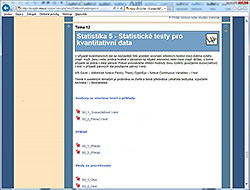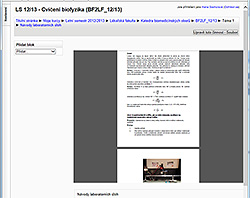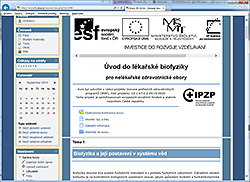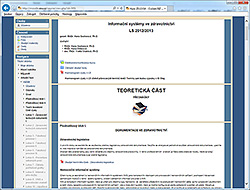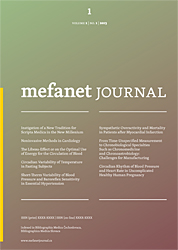
MEFANET Journal 2013; 1(2): 49-54
ORIGINAL ARTICLE
LMS Moodle in teaching biophysics and medical informatics at Faculty of Medicine, University of Ostrava
Hana Sochorová, Hana Materová
Department of Biomedical Sciences, Faculty of Medicine, University of Ostrava, Czech Republic
* Corresponding author: hana.sochorova@osu.cz
Abstract
Article history:
Received 30 September 2013
Revised 6 December 2013
Accepted 12 December 2013
Available online 13 December 2013
Peer review:
Josef Hanuš, Martin Komenda
 Download PDF
Download PDF
The paper deals with the assessment of the current state of use of LMS Moodle for teaching medical biophysics and informatics for students of the Faculty of Medicine, the University of Ostrava. The initial experience with the implementation of blended learning methods (combination of distance and full-time instruction) in teaching students in the part-time form of study were used for education and for full-time students. A few survey questions given to first-year students, which are presented in the paper, confirm that this is a move in the positive direction. A well-structured e-learning course and experienced teachers support student´s attention, motivation and results in achieving educational goals.
Keywords
e‑learning, biophysics, medical informatics, education
Introduction
Figure 1: Survey questions
Figure 2: Answers to the first survey questions
Figure 3: Answers to next survey question
Figure 4: Moodle course for students of the University of Ostrava
Figure 5: Overview of LMS courses in biophysics and information technology guaranteed by the Department of Biomedical Sciences and applied activities
Figure 6: Course of Biophysics I – exercises, part Computing
Figure 7: Biophysics Course I – exercises, part Biostatics
Figure 8: Biophysics Course II - exercises
Figure 9: An Introduction to Medical Biophysics for health care profession courses
Figure 10: Course in IT in Health Care
E-learning is an educational method that integrates information and communication technologies, as a basic communication environment. E-learning is now used as the standard tool in education at most universities. It is basically the usage of electronic material and teaching facilities for effective achievement of the educational goals that are realized through computer networks [1]. While e-learning has been recently applied in distance education it is used nowadays in full-time education, too [2].
LMS are applications which integrate tools for management studies (discussion forum, calendar, deadlined tasks, testing), offering on-line communication (chat, messaging, and conferencing) and also made available learning materials and instructional content [1]. Systems known as CMS (Content Management System) are used mainly as a publication systems for publishing content on the website.
Is Moodle, the most common tool in particular because of its free-of-charge availability, a CMS or LMS? Despite offering resources for the management courses and control of the permeability of study, the system called Moodle meets the requirements of the LMS; it is sometimes classified as a CMS, however. On the moodle.org website the system is presented as “Moodle is a Course Management System (CMS), also known as a Learning Management System (LMS) or a Virtual Learning Environment (VLE). It is a free web application that educators can use to create effective online learning sites” [3].
At the University of Ostrava LMS Moodle has been used for a long time, first courses were started in the academic year 2006/2007. At present the version 2.5.2+ is used. This version allows users to apply the above mentioned pass-conditions to manage students' way through the course [4,5].
Medical students of the University of Ostrava meet with the LMS Moodle during the university admission process, when they recognize one of the important activities – tests. Graduates of secondary schools nowadays enter the university equipped with the knowledge in the field of on-line communication. They are also technically skilled (see results of inquiry) and ready to work with electronic teaching materials. E-learning support studies is applied in this case as so-called blended learning, which complements some minor disadvantages of e-learning by combination with standard teaching methods in teaching full time students [6]. And it can be expected that the objects, which names contain the word base "information", will use these options in the maximum extent.
Method: Questionnaire survey and evaluation of existing practice
At the beginning of the winter semester of the academic year 2013/14 after first few lessons in LMS Moodle General Medicine students were asked several questions relating to the integration of e-learning in full-time education.
At this time in LMS Moodle, there is only one available course in the field of Biophysics, Computer Science I – exercises. Survey questions are shown in Figure 1.
Respondents
Public inquiry investigation was attended by 97 students of the first year of the study program General Medicine, of which 31 were male and 66 female. The Querying activity in the Moodle course was used.
Results of survey
The first question concerned whether the students have ever previously met with lesson supervised through e-learning. This was answered positively by 41% of students (Figure 2, Graph 1). Another question even specified the previous answer – 87% of the students have already met with e-learning in high school, 10% at another university and one student within another education (Figure 2, Graph 2).
In the next question students chose advantages of teaching course with the support of e-learning, which are most appreciated (Figure 3). Having all the learning materials in one place was chosen by the majority as the most important advantage, followed by the "all processed tasks/reports/essay on a given subject can be seen in one place." The students appreciated positively to see demonstrations of solving selected exercises, in case of absence; they can see what they have to learn, get an overview of the content of teaching and immediately can see the results. On the contrary, students voted as the least beneficial the ability to communicate on-line and communication with the teacher and other students in groups. It is obvious that suitable communication tools are already available to them and Moodle does not bring anything new in this regard [7].
Next two questions relate to the possible use of LMS courses for other subjects – 40% of student could not decide whether this option would be beneficial also in other subjects, 46% of students would like to have LMS courses in other subjects. In the latest question students suggested other subjects where the LMS could be used – most often mentioned course was biology, where had been currently implemented tests in Moodle, chemistry (in the summer semester, students will have the LMS Medical Biochemistry course), anatomy and foreign languages.
LMS courses in Biophysics and information technology
After the onset of the study all medical students are offered a Moodle course for students of the University of Ostrava, which get them familiar with the principles of communication, registration of courses, correspondence tasks and other activities used in Moodle.
There have been currently implemented 5 courses for teaching biophysics and informatics in different versions depending on the particular form of study and field of study, which are guaranteed by the Department of Biomedical Sciences.
The table in Figure 5 shows an overview of these courses, their arrangement (Course format), the number of sections and used activities. The most frequently used activities in the particular course are marked with bold font.
Courses for study program General Medicine
The first rate with which students encounter immediately after the onset of the study is Biophysics 1 BF1LF – exercises. It includes all learning materials necessary for the first semester of practical classes in the subjects Biophysics and Computer Technology I. Students in the course hand in ongoing correspondence tasks and finally they complete the practical assessment work. The first version of this course was established in the academic year 2010/2011, for some selected topics of practical lessons.
Since the academic year 2013/14 the course has been realized in an entirely new form that affects the whole syllabus of the first semester of teaching, including biostatistics. Approximately 300 students have passed through the course.
Biophysics 2 BF2LF is the course for the second semester of Biophysics (tutorial) and provides students with instructions for laboratory tasks, space for submitting reports, and links to other recommended sources. In addition to these two courses in Biophysics there is still used a special course created purposefully for testing which is a part of final assessment of students.
Courses for non-medical health care fields of study
Biophysics
The course Introduction to Medical Biophysics for Health Care Professions is being implemented from the academic year 2011/2012. The course is designed for students of full-time and part-time studies studying in the study program Physiotherapy, Radiographer and Rescue Ranger. The chapters of the course are incorporated into the next e-learning course in the subject of Selected Topics in Physics and Biophysics, which is designed for students studying in the study program Medical Laboratory Technician and Public Health Protection Assistant and it is extended to selected topics of elementary physics.
Information technologies
Information systems in healthcare are compulsory subject for all non-medical fields of study.
For the students in part-time form of study the lessons have been supported by e-learning course since 2006, for the students in full-time study since 2009. In the year 2012 in the course IT Systems in Health care there were processed 2 texts underlying the course content – IT Systems in Health Care – Medical Records and IT Systems in Health Care – the Practical Application of Computer Technology. In addition, in 2006, it was prepared a course to the teaching Hospital Information System, which is still available to students. All courses after completing the course in the current semester are moved to the archive [8], where the teacher can, if necessary, let students remain accessible throughout during the study period.
Discussion
The questionnaire survey showed that students like full-time teaching with the support of e-learning; they got familiar with this method of teaching at secondary schools and would welcome its introduction in other courses. Classes conducted in the form of blended learning provide students with new skills – ability to work with electronic resources in various formats, search for relevant information, the use of other software tools, etc.
This method of teaching provides tools for motivation increase and independent approach to the study. The motivating factor is the fact that students can see the results of their work, even self-evaluation tests. At this point, there is very important role of the teacher/tutor of whom are placed fairly high expectations. If the student does not receive a response relatively quickly, the effect of motivation is lost. This feature is especially important for students of the part-time form of study, for the students in full-time study it can maintain and support the motivation by frequent meetings.
For university studies an internal motivation to study and the ability of self-control in coping with a number of new knowledge are largely required. Well-structured and lectured course is really supporting in the study [9].
In general, we can conclude that some of the valued benefits for students, on the other hand, mean increased demands on teachers, especially in the area of timely communication with students. On the other hand, the lecturer has immediate feedback, a comprehensive overview of the performance and activities of the students, which can eventually simplify the evaluation the student's work.
Because the courses are offered for more fields of study, the proper setup of access rights to individual learning materials, setting deadlines of tasks, setting deadlines of attendance of tutorials for part-time studies, access to testing and its security are very important. In the courses there is used a group mode (visible groups) and grouping, which allows lecturers targeted access to materials and scheduling tasks [10].
In addition to publishing of learning materials also links to other materials freely available on the web and almost all of the offered activities – surveys, questionnaires, tests, wikis, discussion forums are used in our LMS courses.
Conclusion
Based on several years of experience using Moodle to enhance learning in part-time and full-time study, we can conclude that the method of blended learning has been very effective in practice, and we consider it as a step in the positive direction.
In practice that means that teachers must constantly keep teaching materials up to date, as well as add new information during the course, thoughtfully divide materials and display it in the way so as to motivate the students and force the students to be active not only during the lessons, but also during self-study at home. Appropriately selected learning methods lead to the achievement of educational goals.
References
[1] Barešová A. E-learning ve vzdělávání dospělých. Vox: Praha 2011. ISBN 978‑80‑87480‑00‑7.
[2] Georgouli K, Skalkidis I, Guerreiro P. A Framework for Adopting LMS to Introduce e-Learning in a Traditional Course. J Educ Technol Soc 2008; 11(2): 227-240.
[3] Welcome to the Moodle community. [On-line] Available at WWW: <https://moodle.org/>
[4] Ostravská univerzita v Ostravě. eLearning … studium kdykoliv a odkudkoliv. [On-line] Available at WWW: <http://moodle.osu.cz/>.
[5] Sehnalová V. Possibilities of LMS Moodle for Adapt of a Learning Course. In Moderní vzdělávání: technika a informační technologie. Univerzita Palackého v Olomouci: Olomouc 2011. ISBN 978-80-244-2912-0.
[6] Rohlíková L, Vejvodová J. Vyučovací metody na vysoké škole. Grada: Praha 2012. ISBN 978‑80‑247‑4152‑9.
[7] Deng L, Tavares NJ. From Moodle to Facebook: Exploring students' motivation and experiences in online communities. Comput Educ 2013; 68: 167-176.
[8] Ostravská univerzita v Ostravě: archív eLearning OU. [On-line] Available at WWW: <http://moodlearchiv.osu.cz/>.
[9] Nunez JC, Cerezo R, Bernardo A, Rosario P, Valle A, Fernandez E, Suarez N. Implementation of training programs in self-regulated learning strategies in Moodle format: Results of a experience in higher education. Psicothema 2011; 23(2): 274-281.
[10] Despotović-Zrakić M, Marković A, Bogdanović Z, Barać D, Krčo S. Providing Adaptivity in Moodle LMS Courses. J Educ Technol Soc 2012; 15(1): 326-338.
Please cite as:
Sochorová H, Materová H. LMS Moodle in teaching biophysics and medical informatics at Faculty of Medicine, University of Ostrava. MEFANET Journal 2013; 1(2): 49-54. Available at WWW: http://mj.mefanet.cz/mj-02130930.
This is an open-access article distributed under the terms of the Creative Commons Attribution-NonCommercial-ShareAlike 3.0 License (http://creativecommons.org/licenses/by-nc-sa/3.0/), which permits unrestricted use, distribution, and reproduction in any medium, provided the original work, first published in the MEFANET Journal, is properly cited. The complete bibliographic information, a link to the original publication on http://www.mj.mefanet.cz/, as well as this copyright and license information must be included.
